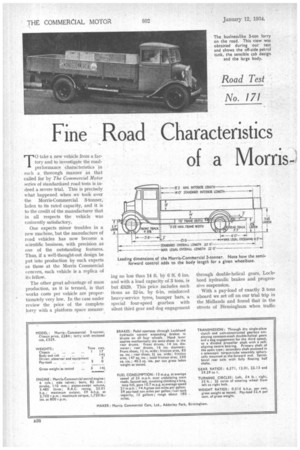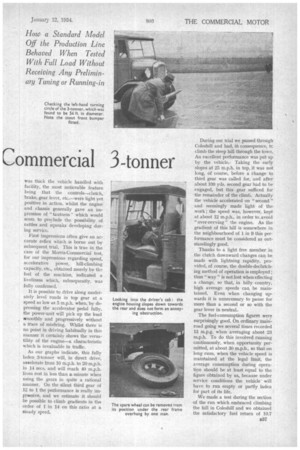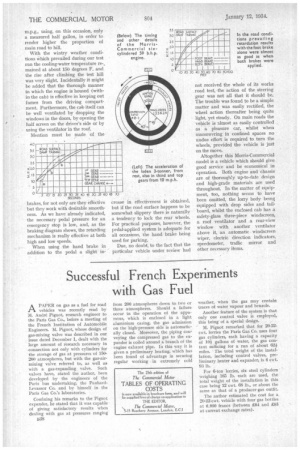Fine Road Characteristics of a Morris
Page 54

Page 55

Page 56

If you've noticed an error in this article please click here to report it so we can fix it.
Commercial 3-tonner. TO take a new vehicle from a factory and to investigate the roadperformance characteristics ' in such a thorough manner as that called for by The Commercial Motor series of standardized road tests is indeed a severe trial. This is precisely what happened when we took over the Morris-Commercial 3-tonner, laden to its rated capacity, and it is to the credit of the manufacturer that in all respects the vehicle was eminently satisfactory.
One expects minor troubles in a new machine, but the manufacture of road vehicles has now become a scientific business, with precision as one of the outstanding features. Thus, if a well-thought-out design be put into production by such experts as those at the Morris Commercial concern, each vehicle is a replica of its fellow.
The other great advantage of mass production, as it is termed, is that works costs per vehicle are proportionately very low. In the case under review the price of the complete lorry with a platform space measur ing no less than 14 IL by 6 ft. 6 ins. and with a load capacity of 3 tons, is but £329. This price includes such items as 32-in. by 6-in. reinforced heavy-service tyres, bumper bars, a special four-speed gearbox with silent third gear and dog engagement through double-helical gears, Lockheed hydraulic brakes and progressive suspension.
With a pay-load of exactly 3 tons aboard we set off on our trial trip in the Midlands and found that in the streets of Birmingham when traffic was thick the vehicle handled with facility, the most noticeable feature being that the controls—clutch, brake, gear lever, etc.—were light yet positive in action, whilst the engine and chs_csis generally gave an impression of "tautness which would seem to preclude the possibility of rattles and squeaks developing during service.
First impressions often give an accurate reflex which is borne out by subsequent trial. This is true in the case of the Morris-Commercial test, for our impressions regarding speed, accelerative power, hill-climbing capacity, etc., obtained merely by the feel of the machine, indicated a liveliness which, subsequently, was fully confirmed.
It is possible to drive along moderately level roads in top gear at a speed as low as 5 m.p.h. when, by depressing the accelerator pedal fully, the power-unit will pick up the load , smoothly and progressively without a trace of misfiring. Whilst there is no point in driving habitually in this manner it certainly shows the versatility of the engine—a characteristic which is invaluable in traffic.
As our graphs indicate, this fully laden 9-tonner will, in direct drive, accelerate from 10 m.p.h. to 20 m.p.h. in 14 secs. and will reach 40 m.p.h. from rest in less than a minute when using the gears in quite a rational manner. On the silent third gear of 12 to 1 the performance is really impreesive, and we estimate it should be possible to climb gradients in the order. of 1 in 14 on this ratio at a steady speed. During our trial we passed through Coleshill and had, in consequence, tc climb the steep hill through the town. An excellent performance was put up by the vehicle.Taking the early slopes at 25 m.p.h. in top, it was not long, of course, before a change to third gear was called for, and after about 100 yds. second gear had to be engaged, but this gear sufficed for the remainder of the climb. Actually the vehicle accelerated on " second " and seemingly made light of the work ; the speed was, however, kept at about 12. m.p.h., in order to avoid " over-revving " the engine. As the gradient of this hill is somewhere in the neighbourhood of 1 in 9 this performance must be considered as outstandingly good.
Thanks to a light free member in the clutch downward changes can be made with lightning rapidity, provided, of course, the double-declutching method of operation is employed ; thus " way " is not lost when effecting a change, so that, in hilly country, high average speeds can be maintained. Even when changing upwards it is unnecessary to pause for more than a second or so with the gear lever in neutral..
The fuel-consumption figures were surprisingly good. On ordinary mainroad going we several times recorded 13 m.p.g. when averaging about 23 m.p.h. To do this involved running continuously, when opportunity permitted, at about 30 m.p.h., so that on long runs, when the vehicle speed is maintained at the legal limit, the average consumption during operation should be at least equal to the figure obtained by us, because under service conditions the vehicle will have to run empty or partly laden for part of its life.
We made a test during the section of the run which embraced climbing the hill in Coleshill and we obtained the satisfactory fuel return of 10.7 m.p.g., using, on this occasion, only a measured half gallon, in order to render higher the proportion of main mad to hill.
With the wintry weather conditions Which prevailed during our test run the cooling-water temperature re-, mained at about 150 degrees F. and the rise after climbing the test hill was very slight. Incidentally it might be added that the thorough manner in which the engine is housed (within the cab) is effective in keeping out fumes from the driving compartment. Furthermore, the cab itself can be well ventilated by dropping the windows in the doors, by opening the half screen on the driver's side or by using the ventilator in the roof.
Mention must be made of the
brakes, for not only are they effective but they work with desirable smoothness. As we have already indicated, the necessary pedal pressure for an emergency stop is low, and, as the braking diagram shows, the retarding mechanism is really effective at both high and low speeds.
When using the hand brake in addition to the pedal a slight in crease in effectiveness is obtained, lout if the road surface happens to be somewhat slippery there is naturally a tendency to lock the rear wheels. For practical purposes, however, the pedal-applied system is adequate for all occasions, the hand brake being used for parking.
Due, no doubt, to the fact that the particular vehicle under review had not received the whole of its works road test, the action of the steering gear was not all that it should be. The trouble was found to be a simple matter and was easily rectified, the wheel action thereafter being quite light, yet steady. On main roads the vehicle is almost as easily controlled as a pleasure car, whilst when manceuvring in confined spaces no undue effort is required to turn the wheels, provided the vehicle is just on the move.
Altogether this Morris-Commercial model is a vehicle which should give good service and be economical in operation. Both engine and chassis are of thoroughly up-to-date design and high-grade materials are used throughout. In the matter of equipment, too, nothing seems to have been omitted, the lorry body being equipped with drop sides and tailboard, whilst the enclosed cab has a safety-glass three-piece windscreen, a roof ventilator and .a rear-view window with another ventilator above it, an automatic windscreen wiper, electric direction indicators, speedometer, traffic mirror and other necessary items.




































































































